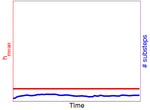screenshots.
number of patches.
These images were generated with Freecloth 0.7.1, using the default simulation parameters. The horizontal axis shows the progression of the simulation over time, and the vertical axis shows the effects of increasing the number of patches used in the simulation.
motion.
For small numbers of patches, the shape of the cloth is distorted. For example, consider the 1.2s column. At 11x11, there is a square-shaped block of cloth in the middle of the front side that stays together, forming a sharp vertical crease. At 22x22, this crease is still present, but it starts to break up in 33x33, and has disappeared in the 66x66 simulation. The cloth can only bend at triangle edges (see the energy diagrams below to see the triangles more clearly), and in low-patch simulations there are very few edges where bending can occur, resulting in distortions like this.
For this simulation, 66x66 seems to be the minimum size needed for distortion-free simulation. Simulations with higher numbers of patches look almost identical to the 66x66 case, while simulations with a lower number of patches have clearly different folding patterns. The only difference between 66x66 and 132x132 is the position of a few vertical folds in the centre of the image. When the simulation advances past 2 s, these folds slowly move outwards to the corner; the only difference between the 66x66 and 132x132 cases is the amount of time required for the fold to reach the corner.
The simulation time for small cloth sizes is distorted by the need to save snapshots. When screenshots are not saved, the 11x11 cloth required only 12 seconds to simulate instead of 41 seconds.
| 0.4 s | 0.8 s | 1.2 s | 1.6 s | 2.0 s | 2.4 s | |
|---|---|---|---|---|---|---|
| 11x11 0:41.28 [mpeg] |
 |
 |
 |
 |
 |
 |
| 22x22 1:04.19 [mpeg] |
 |
 |
 |
 |
 |
 |
| 33x33 1:28.87 [mpeg] |
 |
 |
 |
 |
 |
 |
| 66x66 4:42.43 [mpeg] |
 |
 |
 |
 |
 |
 |
| 99x99 12:02.87 [mpeg] |
 |
 |
 |
 |
 |
 |
| 132x132 24:10.09 [mpeg] |
 |
 |
 |
 |
 |
 |
energy.
In these images, the patches are more visible, as is the triangulation of each patch. The triangulation direction has a strong effect on the 11x11 simulation (compare the amount of bending in the front left and front right corners), but has little effect in simulations with more patches. Once again, we can see that energy distributions are similar for all simulations with 66x66 patches or more.
It is interesting to see that stretch and shear energy are mostly present in the transient motion of the cloth, and are converted to bend energy as the cloth approaches steady-state.
| 0.4 s | 0.8 s | 1.2 s | 1.6 s | 2.0 s | 2.4 s | |||
|---|---|---|---|---|---|---|---|---|
| 11x11 0:41.28 [mpeg] |
 |
 |
 |
 |
 |
 |
 |
 |
| 22x22 1:04.19 [mpeg] |
 |
 |
 |
 |
 |
 |
 |
 |
| 33x33 1:28.87 [mpeg] |
 |
 |
 |
 |
 |
 |
 |
 |
| 66x66 4:42.43 [mpeg] |
 |
 |
 |
 |
 |
 |
 |
 |
| 99x99 12:02.87 [mpeg] |
 |
 |
 |
 |
 |
 |
 |
 |
| 132x132 24:10.09 [mpeg] |
 |
 |
 |
 |
 |
 |
 |
 |
early energy.
| 0.08 s | 0.16 s | 0.24 s | 0.32 s | 0.40 s | 0.48 s | 0.56 s | |
|---|---|---|---|---|---|---|---|
| 11x11 0:41.28 [mpeg] |
 |
 |
 |
 |
 |
 |
 |
| 22x22 1:04.19 [mpeg] |
 |
 |
 |
 |
 |
 |
 |
| 33x33 1:28.87 [mpeg] |
 |
 |
 |
 |
 |
 |
 |
| 66x66 4:42.43 [mpeg] |
 |
 |
 |
 |
 |
 |
 |
| 99x99 12:02.87 [mpeg] |
 |
 |
 |
 |
 |
 |
 |
| 132x132 24:10.09 [mpeg] |
 |
 |
 |
 |
 |
 |
 |